Features of planting and caring for two-tiered and multi-tiered onions
This onion, which looks like an alien plant, has many popular names: Egyptian, Canadian, horned, viviparous. Despite the amazing resistance to adverse conditions and amazing productivity, multi-tiered onions are still very little known to domestic gardeners.
We decided to fill this gap and tell you more about this amazing plant.
Description of multi-tiered bow
There is no exact information about when and under what circumstances the multi-tiered bow appeared. Presumably, it was developed in China, as indicated by references in Asian herbalists of the 14th and 15th centuries to a bow with several “floors”. It was brought to Europe in the 19th century, where it became known as "Egyptian" and "tree".
Multi-tiered onions came to Russian territory thanks to European travelers. Today it is successfully grown in the northern regions of the country, in Siberia, the Far East and in the middle zone. Three varieties of this onion are registered in the Russian state register.
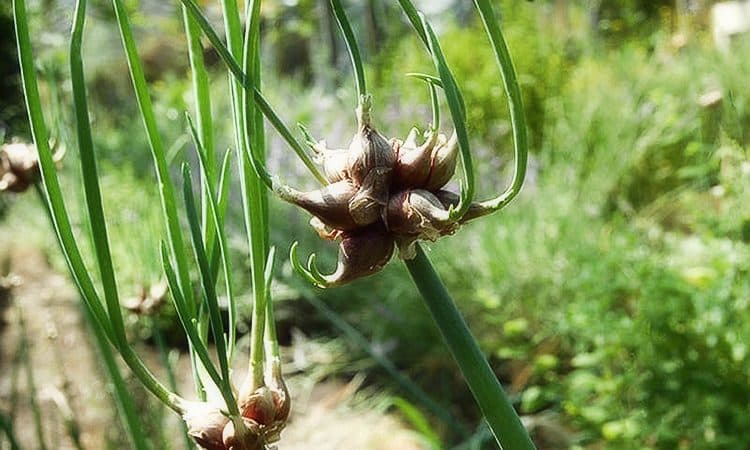
Characteristics of the bulb, appearance, taste
The name “multi-tiered” reflects the main distinctive feature of the onion: it has both underground and aerial bulbs attached to the flower arrow. The first tier is located at a height of 65-80 cm; instead of an inflorescence, a rosette of bulbs is formed here; from it, in turn, a new arrow grows with an “inflorescence” of bulbs.At the first level, aerial bulbs are 2-3 cm in diameter and weigh about 15-25 g; at subsequent levels, their sizes decrease to 3-4 g. Depending on agricultural technology and growing conditions, the number of tiers can be from 2 (then the onion is called two-tiered) up to 5, and the number of bulbs on them is from 3 to 30.
Reference. The unusual appearance of the plant makes it suitable for landscape design. For example, multi-tiered onions are used in rock gardens and allarias.
The underground bulbs grow weighing 40-50 g. The color of the husk depends on the specific variety and can be yellow, brown or purple.
The feathers are hollow and wide - 1.5-2 cm each - reaching a length of 40-50 cm. The green mass is juicy, tastes like onion, but is crispier and more elastic. The taste of the feathers is pleasant until the formation of air bulbs, then the shoots become too bitter and pungent.
Chemical composition, trace elements and vitamins, beneficial properties
Like other members of the onion family, multi-tiered onions are rich in vitamins and beneficial micro- and macroelements. Thus, phytoncides - volatile biologically active substances - have powerful antimicrobial properties. Quercetin is a substance from the flavonoid group and is a strong antioxidant.
In addition, onions contain vitamins A, B1, B2, C and minerals: calcium, magnesium, iron, phosphorus.
Onion juice and compresses are used in folk medicine as a remedy:
- antimicrobial;
- wound healing;
- anthelmintic;
- diuretic;
- hypoglycemic.
Multi-level onions are also used for the treatment and prevention of hypertension, diseases of the stomach and intestines, and in cold therapy.
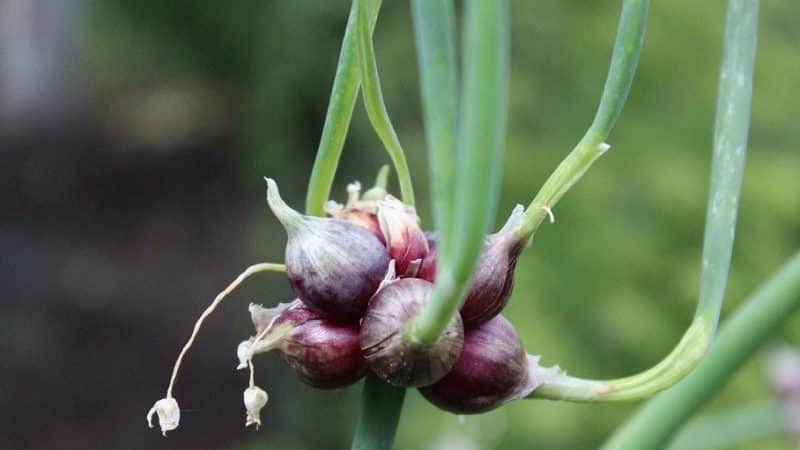
Ripening period
The first edible feathers of green onions can be collected within 21-28 days after planting.Thus, the spring harvest ripens a week earlier than other varieties.
Reference. Feathers are cut off when they reach a length of 30-40 cm. In the first year, it is not recommended to cut more than once per season.
Productivity
In the first year, 2-3 daughter bulbs are formed, each year their number increases to 10-15 pieces. The maximum yield is achieved by the second or third year of growth and is 4 kg per 1 sq. m.
Cut leaves are restored in three weeks, which gives 3-4 harvests per season. In addition, multi-tiered onions do not have a dormant period, so they can be grown for greens all year round in greenhouses or on a windowsill.
Disease resistance
Onions are susceptible to fungal diseases. First of all, downy and true powdery mildew.
Among the worst crop pests are the onion fly and the onion weevil.
Regions for cultivation and climate requirements
Multi-tiered onions easily tolerate both very low temperatures and dry, hot weather. However, sudden temperature changes in autumn and spring can harm a perennial plant.
The crop can be grown in both northern and southern regions, but in conditions of extreme agriculture, planting as an annual is effective.
Advantages and disadvantages of multi-tiered bows
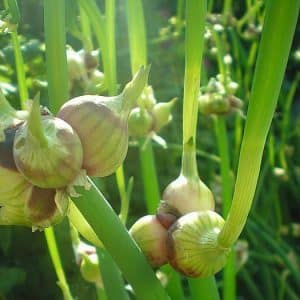
Strengths include:
- High yield.
- Edibility of both feathers and air bulbs.
- Earlier ripening of green mass.
- Almost continuous renewal of the bush throughout the entire non-winter period - from March to November.
- The culture's unpretentiousness and frost resistance make it suitable for cultivation in the northern regions.
Flaws:
- The need for thinning in the 3-4th year of the plant’s life.
- Propagation is only by bulbs, as the seeds do not have time to ripen.
Features of planting and growing
The flowers of the plant dry out before the seeds have time to ripen, so multi-tiered onions are bred using bulbs: aerial and basal. The greatest value is planting material collected from a bush at the age of 3-4 years. Aerial bulbs take root faster.
In addition to growing in open ground, it is permissible to use greenhouses for an earlier harvest or cultivate on window sills and balconies. Let us consider below the features of planting and caring for two-tiered and multi-tiered onions.
Preparing for landing
Before planting, dig up the soil, carefully remove weed roots and remnants of dead vegetation. The soil is fertilized with mineral compounds (20 g of nitrogen, 40 g of phosphorus and 15 g of potassium per 1 sq. m) or rotted compost, then watered with warm water. When the soil dries out a little, use a rake to level the area and prepare grooves for the bulbs.
Reference. Before winter planting, the beds are raised to avoid stagnation of snow and rainwater.
Soil requirements
Double onions grow best in light, breathable loamy soils. In heavy and acidic soil, the harvest will be poor, so peat or sand is added to clay soils, and the acidity is balanced using liming.
Reference. The plant prefers the sunny side of the site - south or southwest.
Predecessors
According to the rules of crop rotation, the most suitable predecessors for onions are nightshades (potato, tomatoes, eggplant), different varieties of cabbage (cabbage, kohlrabi), pumpkin (zucchini, squash), as well as celery, spinach and salad.
Important! Multi-tiered onions cannot be cultivated in the same area for more than five years.
Dates, scheme and rules of planting
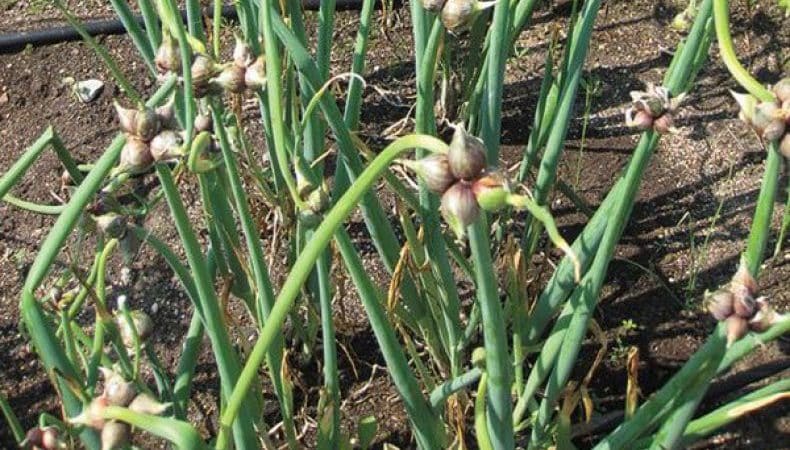
It is best to plant perennials for wintering in late August or early September. Spring planting is carried out using the seedling method and only after the soil has warmed up to +10...+12°C. The soil must be dug up, fertilized and leveled in advance.
To disinfect seed material, the bulbs are soaked in a weak solution of potassium permanganate for 30-40 minutes.
Annual onions are planted to a depth of 3 cm with a distance of 6-8 cm between bulbs and 25-30 cm between rows. If a perennial is needed, planting is carried out according to a square-cluster pattern with a step of 20 cm. The depth of the planting for large bulbs is 10 cm, for small ones - 6 cm. After planting, each bulb is slightly buried in the soil to remove the air cushion.
Features of cultivation
Basic care consists of:
- regular weeding of rows;
- weed removal;
- loosening the soil cover;
- regular watering.
After 3-4 years, onions need thinning, since thickening of plantings leads to the grinding of air bulbs, and the feathers no longer receive enough nutrition. During the procedure, 2-3 underground bulbs are left near the bush, the rest are either eaten or used as planting material.
Reference. As tiers form, the plant becomes taller and heavier. To prevent it from tilting, some gardeners tie the shoots to pegs.
Watering mode
Multi-tiered onions, although not whimsical, love slightly moist soil, so you should not let the soil dry out. But you can’t overwater the soil either.
A sure sign of the need for watering is the drying out of the surface layer. In drought, you may need to moisturize daily, in normal weather - once every two weeks.
Loosening the soil and weeding
After watering, the soil needs to be slightly loosened, so the water will not stagnate and provoke fungal diseases.
Regular weeding prevents weeds from depleting the soil, shading the plantings and attracting various pests.
Top dressing
Winter onions are fed immediately after the snow melts with complex mineral fertilizer.
The second feeding is carried out after the first feather trimming. Rotted manure mixed with wood ash is suitable for this.
Before the first autumn frosts, the soil around the onion bushes is mulched with humus, smoothing it with a layer of 2-3 cm.
Disease and pest control
As a result of thickening of the bulbs and stagnation of water in the soil, plants may develop downy mildew. To prevent the formation of fungal spores, the mother bush is thinned. In case of infection, the damaged specimen must be isolated from healthy plantings and destroyed, and the remaining plants must be treated with Bordeaux mixture.
The best way to prevent onion flies is to plant carrots nearby. These crops create a kind of symbiosis: the smell of onions repels the carrot fly, and the smell of carrots repels the onion fly.
Another dangerous pest, the onion weevil, feasts on succulent feathers. To remove it, you will have to resort to the help of insecticides “Fitoferm”, “Alatar”, etc.
Harvest and storage
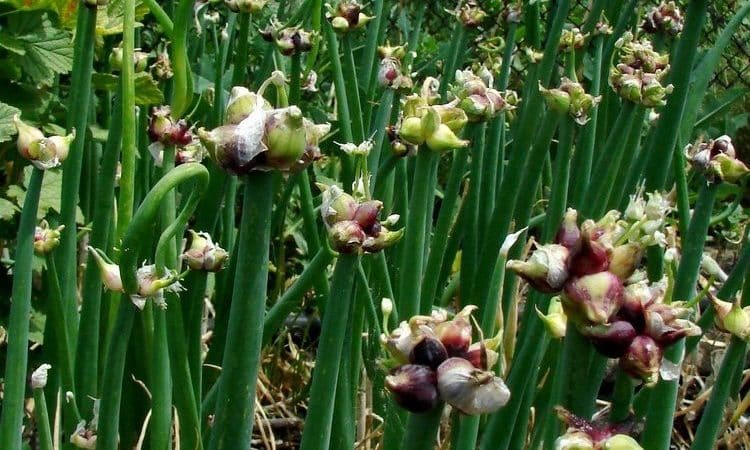
Little by little, onion feathers can be cut off in the fall, but mass cutting is carried out no earlier than June, so that the bush has time to shoot flowers.
The aerial bulbs are harvested in August – early September. If the summer is hot and dry, the harvest is shifted to the end of July-August.Maturity is determined by the presence of brownish tubercles at the bottom of the root system.
Storage features and keeping quality of the variety
Underground bulbs are loose and cannot be stored for a long time. Therefore, they are immediately used as seed material or eaten.
Aboveground bulblets are denser and remain edible for 2-3 months at a temperature of about 0°C. The best way to preserve them for a longer period is to pickle them.
Advice from experienced gardeners
Growing multi-tiered onions is a novelty for many gardeners. All the more valuable is the experience of those summer residents who have been breeding it for many years:
- It is best to lay out the bed in the place where the snow melts first. This will speed up the appearance of the first onion feathers.
- Leaves should not be cut close to the ground. Leave a stump of 5 cm.
- Trellis and other supporting structures should be thought out in advance so that the bushes do not fall under their own weight.
- Pest flies can be repelled without the use of chemicals, for example, by the strong smell of pine needles and wormwood.
Reviews of multi-tiered onions
Two-tiered and multi-tiered onions are actively winning the hearts of amateur gardeners. Its fans note that it grows well in almost any climate.
Oksana, Kazakhstan: «Ask: how to grow a two-story onion? Yes, very simple! I recommend it to everyone, as caring for it is elementary. It overwinters at -40°C and feels great at +40°C in the summer.”
Elena, Russia: “I like it because you can eat any part. When there are a lot of onions, I pull them out by the roots. The head is very tender and tasty. I plant young onions from the second and third tier on greens in a box on the balcony.”
Ivan, Ukraine: “At first I was very surprised - what does planting onions in two tiers mean? But it turned out that such onions are productive and taste good, and do not cause much trouble. One bad thing is that it’s difficult to find planting material.”
Conclusion
Multi-tiered onions are an excellent alternative to the usual green varieties. It has virtually no dormant period, so in a greenhouse or on a balcony it will delight you with lush greenery all year round, and in open beds it looks impressive and unusual.